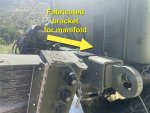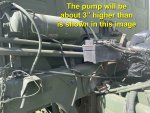- 62
- 37
- 18
- Location
- Hereford, Arizona
We are relocating some components to make room for our subframe and habitat. Two of those components are the hydraulic manifold and the air/hydraulic pump. (We're thinking about replacing the pump with a 12 volt pump, but the OEM pump we have was recently rebuilt and works well.) The manifold will be about two feet higher than it's normal position and will be mounted on the black bracket shown in the picture. We are planning to mount the pump in the location shown in the other picture, but it will be about 3" higher than what is shown in the picture.
When the two components are relocated to their new positions, they will be pretty much level with each other. In their factory installed positions, the pump is much higher than the manifold I know it's a sealed system, but I'm no hydraulics expert, so I was wondering if there is any problem with the relative heights of those hydraulic components being level vs. one higher than the other. Thanks
Kevin
When the two components are relocated to their new positions, they will be pretty much level with each other. In their factory installed positions, the pump is much higher than the manifold I know it's a sealed system, but I'm no hydraulics expert, so I was wondering if there is any problem with the relative heights of those hydraulic components being level vs. one higher than the other. Thanks
Kevin
Attachments
-
420.3 KB Views: 12
-
399.7 KB Views: 12



